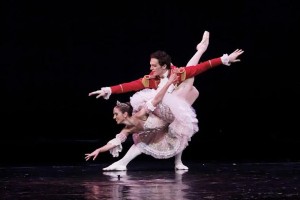THE PHILIPPINE Ballet Theater’s (PBT) “Don Quixote” on July 4 was a qualified triumph for the Kitri of Lobreza Pimentel, who mustered enough energy to survive the two-act ballet known for its severe physical demands.
Her portrayal was a big revelation. The determination to pass the challenge was all over her movements, and, thanks to the Basilio danced by Joseph Phillips, she was able to carve a likable Kitri that was wholly her own, and with some refinements that came with incandescent partnering.
It was obvious the crowd easily connected with Phillips, whose jumps and turns elicited gasps of admiration in the right places.

More than his good looks, this danseur had character and an uncanny ability to blend with the ensemble. He was more than a reliable partner as well, as he took care of his Kitri and made sure she got her share of applause.
Their pas de poisson (“fish dives” to laymen) was most spontaneous and fairly well-executed.
The PBT soloists with guest artist and corps de ballet deserved that long and rousing standing ovation.
The company, now headed by Sylvia Lichauco de Leon, has logged 30 years of existence. Its fine staging of “Don Quixote” might as well be its crowning glory.
The determination of such pioneering mentors as Julie Borromeo, Eddie Elejar, Tita Radaic and Gener Caringal has, indeed, paid off, and how.
This latest “Don Quixote” in Manila is one more big reason why PBT should get equal support from the country’s dance-lovers and corporate sponsors.
Evolution of dance
On July 19, another dance gala was seen at the Cultural Center of the Philippines (CCP), this time under the auspices of the Australian Conservatoire of Ballet (ACB), under Christine Walsh.
It opened with a young girl, Tessa Tordesillas, demonstrating the five basic positions of ballet and how one could spin creative dances out of them.
She was focused, her balance was superb, and her emerging agility showed in every move.
What followed was a dance concert showing the evolution of dance from school to performing-arts venues.
The advance students followed with a dance called “La Lecon,” choreographed by Walsh to the music of Czerny. Here you saw how years of training could result in an edifying performance, showing ballet’s timeless appeal.
Local color followed with “Tagsibol,” choreographed by Jun Saagundo to the music of Grace Nono, and mounted by the Vella C. Damian School of Ballet.
Another enchanting number from the same school was “Magkaugnay,” choreographed by Tony Fabella to the music of Joey Ayala. Here you saw how the basic classical-ballet training could enhance the appeal of local works.
The Fabella choreography stood out seemingly with a statement that Filipino choreographic works had a place in an international ballet repertoire.
The gala with over 15 participating schools succeeded in showcasing the various genres and levels of dancing from different dance studios.
The closing numbers were the grand pas from “Sleeping Beauty” with Benjamin Ella and Akane Takada; and from “Nutcracker” with Irina Sapozhnikova as the Sugar Plum Fairy and Phillips as her Cavalier.
Ella and Takada were a delight to watch, going through the much-anticipated variations, which were punctuated by screams from the audience. Takada had an inner strength and an aura that made her Princess Aurora quite appealing.
In looks, Ella was the perfect prince and a fairly reliable partner. What both could use would be a degree of refinement that would surely come with maturity.
Promising dancers
The “Nutcracker” Suite had the Garland Waltz with promising dancers from Ecole de Ballet Manille; the Spanish Dance ably interpreted by the dancers from ACB; the Arabian Dance by dancers from Acts Manila and other schools.
After the Merlitons Dance and Waltz of the Flowers, the grand pas de deux opened with spectacular leaps and variations from Phillips and Sapozhnikova, both soloists of the Primorsky State Opera and Ballet.
The performance was highly arresting. Sapozhnikova and Phillips ignited the stage with their unique team-up, which took one’s breath away.
Phillips, ever the gallant and reliable partner, showed the makings of a premier danseur. His partner’s amazing solo variations didn’t distract from the fact that he was many times superior as an ensemble dancer.
What was remarkable was that they were dancing with ballet students not associated with Ballet Philippines, Ballet Manila or PBT.
Rigid syllabus
Outside of these major companies are hundreds of ballet students following the rigid ballet syllabus of ACB, which supervises over 300 teachers all over Asia.
The gala coordinators were officers of the Philippine Association for the Advancement of Dance Studies under Damian.
The well-received gala was a celebration of the 20th anniversary of the classical-ballet training spearheaded by ACB under Walsh and Ricardo Ella.
Many years ago, one saw the Odette-Odile (“Swan Lake”) of Walsh at the CCP.
She turned to teaching after her retirement and founded a ballet conservatoire with a handy syllabus outlining a comprehensive ballet-training program based on the Vaganova Method.
What the gala showcased was the ACB hallmark of the revered method, which in simple terms emphasizes correct placement, dynamics and performing quality, not exactly in that order.